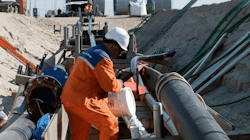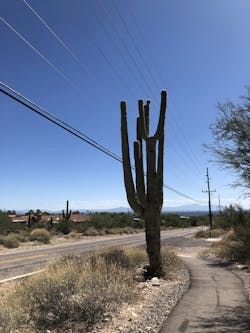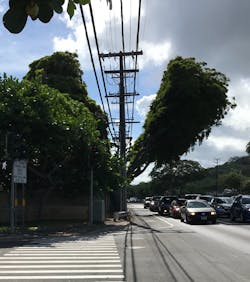Goals have been set for renewables, net-zero and carbon-free energy. These resource-related goals and the U.S. vision for electrification will require a 21st century distribution grid that is reliable, resilient and still affordable. Will it be the distribution grid of our grandparents? Absolutely not.
The electric distribution grid of the future will be a modern, integrated grid that accommodates distributed energy resources like rooftop solar, fuel cells, storage and vehicle-to-grid electric vehicles. This increasingly complex grid that delivers the clean electricity needed for the future must be fundamentally transformed into a new and dynamic technological wonder. Underground electric distribution lines will be an important part of this transformation. Therefore, as ambitious goals are set for clean electricity, the same must be done for the distribution grid that delivers the electricity. I submit that we need to achieve 50% underground by 2040.
Where We Stand
The electric distribution system in America today is approximately 20% underground. Some public power utilities — like Ft. Collins and Colorado Springs, Colorado, and Anaheim, California — have had underground ordinances for years. They have beautified their cities and improved the performance of their systems. Fort Collins is 99% underground and 99.9% reliable. Colorado Springs started in the 1970s and is 77% underground today with 99.9% reliability. The public power utility estimates its entire system can be underground with another US$2.2 billion investment.
Anaheim has been engaged in its Home Underground (HUG) program since 1990, with excellent results. The phone and cable TV utilities in Anaheim paid to go underground, as well.
For years, investor-owned utilities (IOUs) have put new neighborhoods underground. Now, many large IOUs — like Pacific Gas and Electric Co. (PG&E), Florida Power & Light Co. (FPL), WEC Energy Group and Dominion Energy — are engaged in multiyear, multibillion-dollar programs to strategically underground laterals and other key parts of their systems.
PG&E’s Strategy
PG&E will spend US$ 15 billion to US$ 30 billion to underground the first 10% of its system. The utility plans to have 3600 miles (5794 km) of line placed underground by 2026, bringing it one-third of the way to its 10,000-mile (16,093-km) goal. CEO Patti Poppe has said PG&E is being rebuilt from the “underground up.”
The utility has two major programs focused on undergrounding:
- The system hardening program is part of wildfire mitigation efforts. It focuses on strengthening the electric system with stronger poles and covered power lines in addition to undergrounding in or near high fire-threat areas.
- The Rule 20 program undergrounds lines throughout the PG&E service area as part of an effort to make communities more scenic and beautiful.
According to the PG&E website, these wildfire safety and undergrounding efforts make the utility’s system safer and more resilient. This work positions PG&E to better serve its customers and respond to California’s evolving climate challenges. Building and expanding the PG&E electric system underground will provide the following benefits:
- Help stop wildfires caused by equipment
- Reduce public safety outages
- Decrease the need for tree trimming
- Improve system reliability
- Beautify residents’ hometowns.
FPL’s Focus
FPL will ramp up in 2025 to $1 billion per year spend on converting overhead laterals to underground. Its three-year Storm Secure pilot program was so successful in terms of system resiliency and customer acceptance the Florida Public Service Commission is allowing Duke Energy Corp. and Tampa Electric (TECO) to implement similar undergrounding programs.
“After the historic hurricane seasons of 2004-05, when seven hurricanes affected our customers, FPL began making significant investments to strengthen our electric system and make the grid more resilient to severe weather,” according to the FPL website. “When Hurricane Irma struck in 2017, our hardening efforts helped significantly reduce damage to the grid and speed restoration for our customers. Still, we saw that the No. 1 cause of outages during Irma was debris blowing into and trees falling onto our power lines.”
WEC’s Way Forward
WEC Energy Group’s Wisconsin Public Service has undergrounded 2000 miles (3219 km) of overhead lines in the last eight years, increasing its percent underground from 27% to 39%, with very high customer satisfaction and customer willingness to pay for the underground. This success will carry over to WEC Energy’s other companies as part of its progressive Delivering the Future initiative.
Paul Gogan, director of electric distribution asset management for WEC Energy Group, said, “The underground projects have been a game-changer for WEC Energy Group. They have exceeded expectations, improved reliability and increased customer satisfaction. The projects have resulted in more than a 97% reduction in electric outage minutes in those areas where overhead lines have been replaced with underground circuits.”
Dominion Energy started its strategic undergrounding program almost 10 years ago. Today, it has achieved better system resiliency supported by empirical data. The utility often shares its lessons learned and best practices, especially when it comes to customer involvement and satisfaction.
Dominion Energy’s promise to customers leads the industry: “Customers can expect consistent outreach during every phase of a strategic undergrounding project (SUP) because communication coordinators and project managers are assigned to all projects and directly communicate with property owners. We have a robust communication strategy that includes updates via mail, door-hangers, phone, email and more! We also partner with contractors who help keep our customers informed every step of the way.”
Defining Reliability
These utilities are starting to understand the total value of underground over the life of the asset. The data used to understand total value includes capital costs, reduced operations and maintenance (O&M) cost, lost local GDP, and safety exposure, customer satisfaction, reliability measured in minutes and
resiliency measured by total time of line restoration.
Resiliency is defined as the ability to withstand a high-impact, low-probability (HILP) event with little or no customer outages. Like reliability, there is value in resiliency. Planners and engineers must do the total cost of ownership analysis and quantify the value of resiliency when possible. It is their responsibility to make prudent system evaluations that support fundamental business decisions for utility executives, regulators and, ultimately, customers. Increasingly, they are doing just that.
However, not everyone is an early adopter or fast follower. Tucson Electric Power (TEP), Hawaiian Electric Co. (HECO) and Puget Sound Energy (PSE) want to build controversial overhead power lines in scenic communities with neighbors that do not want the large poles.
TEP’s Overhead Pushback
Citizens question TEP’s cost estimates for undergrounding a 7-mile (11-km) 138 kV line, citing examples that cost as little as half of the utility’s approximately $13 million per mile, or $90 million, estimate. Citizens also question “TEP’s assertion is that maintenance costs of underground lines would be much higher than overhead lines,” according to Tucson Electric Overhead Power Line Plan Runs Afoul of Neighbors, City, an article published in March 2022 by the Arizona Daily Star on Tucson.com.
Property values are an issue for citizens, as well. According to the article, TEP admits the studies it reviewed indicate that “…though short-term impacts to property values can occur, long-term property values are not greatly affected by transmission lines.”
The article also states that TEP suggested the city consider forming an underground taxing district to have affected property owners pay for the undergrounding. “That’s asking people TEP is damaging to pay for TEP not damaging them,” said one citizen quoted in the article.
TEP anticipates the line siting hearing to consider its overhead line plan application will be rescheduled for the first quarter of 2023.
HECO’s Estimate
Should 46 kV in a beautiful new master planned community in paradise be underground or overhead? According to HECO, the cost to install overhead power lines would be US$ 6.7 million while undergrounding would cost $25 million. However, that is its estimate of capital cost. Some questions must be asked about the estimate:
- What is the total cost of ownership of these overhead lines compared to underground lines for the life of the asset?
- How much will vegetation management and tree-related outages really cost 20 years from now?
- What is the cost to utility and customer safety?
- What is the gross domestic product cost of an outage for small businesses?
In this case, planners and engineers need to address these legitimate questions (and others) as they decide to build more overhead or underground electric transmission and distribution across America. The Hawaiian neighbors have excellent points of concern and continue to meet with the developers and HECO.
PSE’s 10-Year Request
Puget Sound Energy (PSE) issued the first project-need report for its Energy East transmission upgrade project in February 2012. Today, more than 10 years later, PSE is one permit away from getting approval to build a 230-kV line in place of the existing 115-kV line. However, is the need the same? Do better alternatives exist now, 10 years later? Did anyone evaluate the lost goodwill and reputation of a utility that battles its customers for 10 years?
Those customers started Citizens for Sane Eastside Energy. Sadly, the PSE customers use words like “lies” and “fraud” in their years-long opposition to the controversial PSE project. According to the Citizens for Sane Eastside Energy website, it is a “public forum for citizens on the Eastside who oppose Puget Sound Energy’s proposed Energize Eastside project.”
Time Will Tell
There must be a better way to build electric infrastructure in communities. What is the customer cost in lost local gross domestic product of an outage? What will the cost of tree trimming be in 5 and 10 years from now? How can truck rolls be reduced and environment, social and governance (ESG) improved? How can worker and public safety be improved? How can the streetscape be beautified and the quality of life of customers improved? What can be a new and positive part of improved customer service? Electric utilities are asking these questions and, increasingly, the answer is underground.
As demonstrated, some utilities are leading the industry — like public power underground advocates in Anaheim, Ft. Collins and Colorado Springs as well as IOUs like PG&E, Dominion Energy, WEC Energy and FPL — with customer-focused, progressive ideas for planning, design and construction of large underground programs. Some utilities choose not to lead, but their time will come.
So, is 50% underground by 2040 an unreasonable goal? Of course not. In fact, it might be too low. Are the goals for renewables, net zero and carbon free energy unreasonable? Again, no, but the nation will need a state-of-the art electric T&D grid to support the ambitious clean resource goals of the future.
Will the electric utility industry drive real cost out of O&M? Will the industry specify an underground grid with better equipment, cables, splices and terminations? Will the latest construction methods and technologies be embraced? Will we use factory-comparable field-quality control tests and underground-line-sensing technology married with artificial intelligence to verify systems are installed correctly, according to their cable specifications? Will 50% be transformational or would more like 75% underground be needed to achieve our electrification, reliability and resiliency goals and significantly impact shareholder and customer value?
These issues will be addressed in the year to come. The industry needs to have a debate. Will 50% underground by 2040 be enough? Will electric utility stakeholders agree? Time will tell.
Mike Beehler ([email protected]) has over 40 years of electric T&D experience at Tucson Electric Power, Hawaiian Electric Company and Burns & McDonnell. He is educated as a civil/structural engineer at the University of Arizona and is a registered professional engineer in eight states. He currently is the founding member and Chief Opportunity Officer of Mike Beehler & Associates, LLC and serves as the National Spokesman for the Power Delivery Intelligence Initiative. Beehler is a Fellow in ASCE and a Member of CIGRE and IEEE.
About the Author
Mike Beehler
Vice President
Mike Beehler P.E., ([email protected] ), is the national spokesperson for the Power Delivery Intelligence Initiative and the chief opportunity officer for Mike Beehler & Associates LLC. He started his career designing and building transmission lines and substations for Tucson Electric Power and the Hawaiian Electric Co. and then spent more than 20 years designing T&D infrastructure and consulting on emerging trends at Burns & McDonnell. He has written, presented and consulted on reliability-centered maintenance, critical infrastructure protection and program management. In addition, he is a well-known industry writer and speaker on the early definition of the smart grid, 3-D and building information modeling applications in T&D, and development plans for smart cities. Most recently, he is sought for his strategic leadership and vision on the application of emerging technologies in changing business models to include the integration of distributed energy resources, augmented/virtual reality and artificial intelligence. He authored the book, The Science of the Sale. Beehler is a registered professional engineer in Arizona, Florida, Hawaii, Texas, Colorado, Kansas, Georgia and Alabama. He also is a Fellow in the American Society of Civil Engineers and a member of IEEE and CIGRE.





